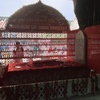Disclaimer
This entry contains information known to us from a variety of sources but may not include all the information currently available. Please be in touch if you notice any inadvertent mistakes in our presentation or have additional knowledge or sources to share. Thank you.
Archive
Sarmad Kashani Tomb in Jami Masjid, New Delhi, India
Tomb of Sarmad Kashani in the Jami (Jama) Masjid mosque, New Delhi, India.
Description
Sarmad Kashani, a Persian-speaking Jew from an Armenian Jewish merchant family, is buried in the Jami Masjid mosque in New Delhi, India. Sometime in the 1630s, Sarmad arrived in the courts of Shah Jahan in Delhi and Agra and became close to both the Shah and his oldest son, the heir presumptive. Sarmad had an interesting career trajectory. He was a Jew who became a Muslim, then a Hindu and, finally, an atheist. He discovered a homosexual lover, and as a result, abandoned his wealth and turned ascetic, wandering through the imperial courts as a naked fakir. A brilliant linguist, Sarmad translated the Torah into Persian. He also ridiculed all major religions of his time but was very popular as both a poet and a philosopher. Aurangzeb, an evil son of Shah Jahan who killed his oldest brothers and imprisoned his father in order to get on the throne, never forgave Sarmad for his friendship with his father and his brother. In 1661, he had Sarmad arrested and beheaded for his heretical poetry. Then, Sarmad’s final transformation happened: he became venerated as a great Sufi, an Islamic mystic, and was buried in a shrine in Jami Masjid where the anniversary of his death is commemorated annually in a festival.1
Sources
1Irene Shaland, The Dao of Being Jewish and Other Stories: Seeking Jewish Narrative all Over the World, CreateSpace, 2016.
Photos Courtesy of Alex Shaland and A. Yadav
See also globaltravelauthors.com

